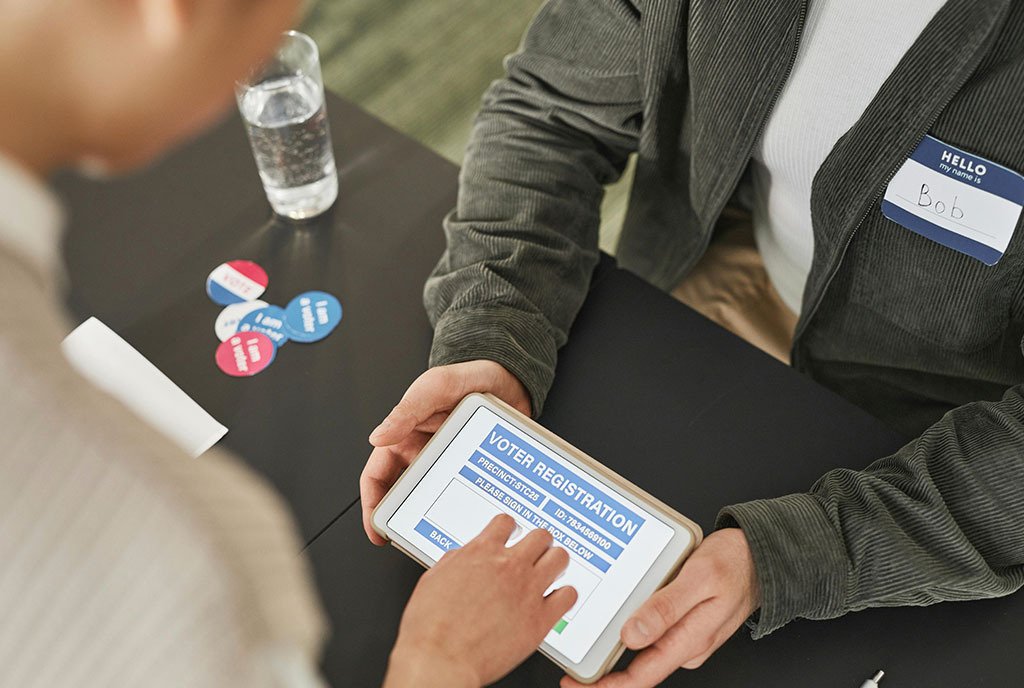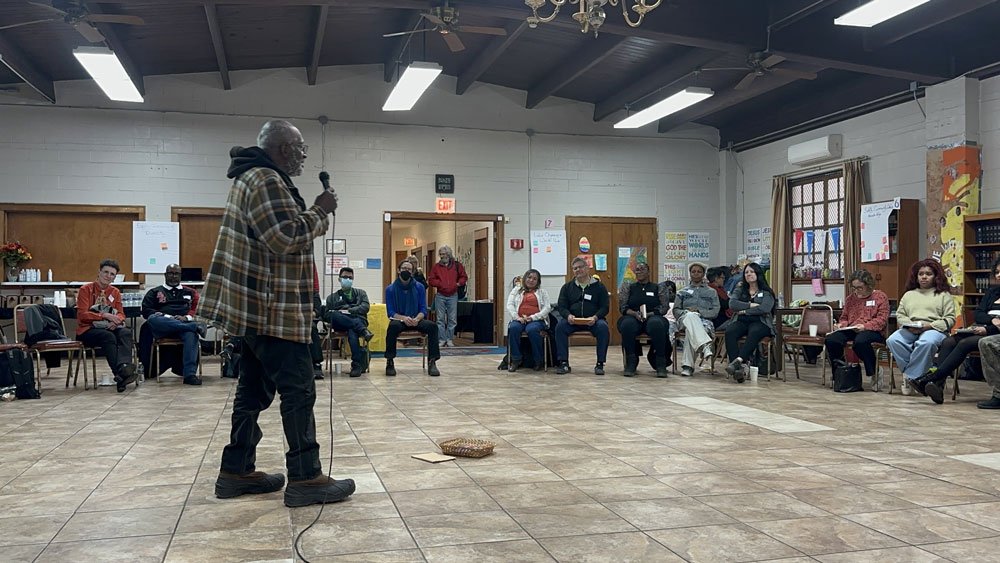
This article was updated on August 14, 2024.
The 2024 election, likely to be one of the most consequential—and closest—presidential contests in recent history, is upon us.
Nonprofits are, in some ways, uniquely positioned to ensure that every eligible voter’s voice, whatever their political persuasion, is heard. And the potential is not just hypothetical. Prospective voters contacted by nonprofits about voting are 10 percentage points more likely to vote than those who are not, according to research by Nonprofit VOTE.
Yet, as NPQ has previously reported, relatively few nonprofits—just over one-tenth—practiced voter engagement in 2022.
Nonprofit 501c3 organizations are prohibited from participating in partisan politics, but they are allowed to engage voters with nonpartisan information, registration, and voting assistance.
Prospective voters contacted by nonprofits about voting are 10 percentage points more likely to vote than those who are not.
The nonprofit sector has the opportunity to make a difference, and it’s not too late to start trying, said experts in a recent webinar hosted by the National Council of Nonprofits in partnership with Nonprofit VOTE, which works to educate and encourage nonprofits to include voter engagement in their work.
“Remaining nonpartisan means that we are not engaging with or advocating for or advocating against any candidates,” said Gwen Stembridge, Nonprofit VOTE education and partnerships coordinator. “It doesn’t mean, though, that we can’t talk about the issues that are important to the people that we’re working with, that we’re serving.”
And such work, Stembridge argued, falls right in line with many nonprofits’ missions of improving society.
“We can build this more equitable democracy,” Stembridge noted, “if we ensure that there’s a level playing field for everyone who is eligible to vote.”
Legal Lines
Before nonprofits embark on voter engagement programs, they need to have some guardrails in place. As a condition of their tax-exempt status, 501c3 organizations are “absolutely prohibited from directly or indirectly participating in, or intervening in, any political campaign on behalf of (or in opposition to) any candidate,” as the IRS puts it.
“We can build this more equitable democracy.”
But nonprofits can still do a great deal in the electoral realm.
As long as the following activities are conducted in a nonpartisan manner, nonprofits may:
- Register voters directly
- Assist in voter registration
- Educate voters about upcoming elections, candidates, and ballot measures
- Engage directly with candidates
- Host educational candidate events
- Take positions on ballot measures
Voter Registration
Nonprofits can actively register voters by reaching out to their constituents—the people they serve—and by holding public events, such as setting up tables outside supermarkets or community centers. Nonprofit employees or volunteers can help prospective voters fill out registration forms or enter the information online if state election agencies make this option available.
Nonprofit workers and volunteers need to know the specific requirements and processes for voter registration in their communities. State election offices are important resources for this information.
Sign up for our free newsletters
Subscribe to NPQ's newsletters to have our top stories delivered directly to your inbox.
By signing up, you agree to our privacy policy and terms of use, and to receive messages from NPQ and our partners.
Nonprofit VOTE offers a voter registration toolkit, and on September 17, it will use National Voter Registration Day to get as many voters registered as possible.
Voter Education
Nonprofit workers and volunteers can provide information about the registration process and election dates, polling locations, and hours.
They can also educate voters about elections, for instance, helping identify and convey information about candidates for down-ballot offices who might have lower profiles than those at the national level but who often have a greater impact on community issues.
For first-time voters, it may be helpful to explain the voting process, for example, how to fill out a paper ballot or use an electronic voting machine. State and local election offices often offer sample ballots, which can be valuable learning tools. Nonprofits that offer instruction may consider folding voter education into their classes.
Candidate Outreach
Nonprofits can host nonpartisan informational events, including candidate forums — provided that all viable candidates are invited and given an equal opportunity to make their case. They can also educate candidates about issues that impact their communities. According to the National Council of Nonprofits’ Voter Engagement Guide, these events serve a couple of purposes: “The invitation alone gets your organization’s name and mission in front of the candidates,” and they allow “your constituents and stakeholders to ask questions and familiarize themselves with their choices.”
Nonprofits may also consider sending out questionnaires to candidates and publishing the responses as part of nonpartisan candidate guides. For candidate forums and questionnaires, nonprofits must abide by the principles of fairness and equal time for all candidates. In all candidate engagement, the nonprofit should clarify that all candidates were contacted and that the nonprofit is committed to being nonpartisan. The Voter Engagement Guide offers additional details and best practices for ensuring events and candidate guides remain nonpartisan and balanced.
Best Practices for Voter Engagement
Voter engagement can be resource-intensive, so it’s a good idea for nonprofits to clarify their goals at the outset. This starts with identifying the target audience for voter outreach. The audience could consist of the entire service population, or the nonprofit may take a more modest approach and start with its own employees and volunteers.
“Think about who that audience is and how you can focus on it. There is no shame in starting small,” Stembridge said. “You can build a program that really works, and then you can build it up later if you want to.”
Partnership is also an important element in any voter-engagement strategy. Likely partners include local election offices and other nonprofits that can help expand the pool of potential voters and even offer expertise in voter outreach.
“As often scrappy nonprofit leaders, we know that partnering with other organizations is so key. We have to do this together. We cannot do this in competition with one another,” Stembridge said.
“I really want to reframe that idea of ‘apathetic’ voters, to talk [instead] about disconnected voters.”
The Perils and Opportunities of Social Media
A nonprofit’s social media channels can help amplify voter outreach efforts, but organizations should also be mindful of how individual employees and volunteers express themselves on these channels, especially in the current politically charged climate. While employees of nonprofits are free to express their political opinions on their personal social media channels, they should not speak as representatives of the nonprofit.
“You can take off your nonprofit worker hat and speak about an issue,” Stembridge said, adding, “You don’t want to be in a situation where you are putting your nonprofit at risk because of something that you’re saying.”
Nonprofits may find that some constituents are wary of or skeptical about voting. Brainstorming potential responses to these concerns and even having scripts on hand to use in hypothetical conversations can help overcome this resistance.
“I really want to reframe that idea of ‘apathetic’ voters, to talk [instead] about disconnected voters,” Stembridge said. “They’re not making the connection between them voting and what’s happening in their communities. And so, as nonprofits, we can help to make that connection happen.”











